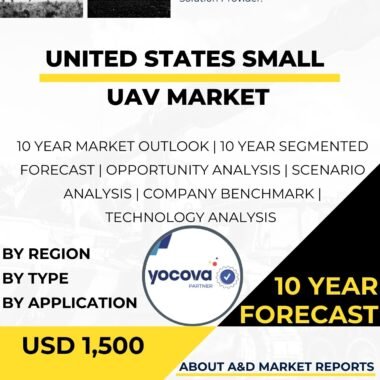Description
The Saudi Arabia Small Unmanned Aerial Vehicle (UAV) Market is a crucial and rapidly expanding segment within the country’s defense and commercial industries. Small UAVs, also known as drones, are unmanned aircraft with a maximum takeoff weight of less than 55 pounds. These versatile and cost-effective aerial platforms have various applications, ranging from military surveillance and reconnaissance to commercial aerial photography, agriculture, and infrastructure inspections.
As a key player in the Middle East region, Saudi Arabia recognizes the strategic importance of acquiring and developing advanced small UAV capabilities to enhance its national security, support its defense operations, and drive innovation in various civilian sectors.
The Saudi Arabia Small UAV Market is characterized by a mix of international and domestic manufacturers that specialize in UAV development and production. International UAV technology providers, such as DJI, Parrot, and Textron, have a significant presence in the market and offer a wide range of small UAV solutions.
One of the primary drivers of the Saudi Arabia Small UAV Market is the country’s focus on strengthening its defense and security capabilities. Small UAVs provide valuable intelligence, surveillance, and reconnaissance (ISR) capabilities to military forces, enabling them to gather real-time data on potential threats, monitor critical infrastructure, and conduct border surveillance.
In addition to defense applications, small UAVs offer numerous benefits to civilian sectors in Saudi Arabia. The use of UAVs in agriculture allows for precision farming, optimizing crop health, and enhancing yields. In the commercial sector, small UAVs are utilized for aerial photography, mapping, infrastructure inspections, and monitoring of construction sites.
The Saudi government’s Vision 2030 economic diversification plan also influences the Small UAV Market. As part of this vision, Saudi Arabia aims to develop a robust domestic UAV industry capable of contributing significantly to the national economy. This includes fostering partnerships and joint ventures with international UAV manufacturers for technology transfer and knowledge sharing.
Localization of UAV manufacturing aligns with the broader goal of creating high-skilled job opportunities for Saudi citizens and promoting research and development within the country.
Fixed-wing UAVs resemble traditional airplanes and are used for longer endurance missions, such as reconnaissance, surveillance, and mapping. They can cover larger areas and stay in the air for extended periods compared to multirotor UAVs.
Multirotor UAVs, such as quadcopters and hexacopters, are highly maneuverable and can take off and land vertically. They are ideal for close-range inspection tasks and are widely used in commercial applications.
Hybrid UAVs combine features of both fixed-wing and multirotor UAVs, allowing them to take off and land vertically like multirotors and transition to efficient fixed-wing flight for longer-range missions.
Nano and micro UAVs are the smallest category of UAVs, often used for indoor surveillance, exploration, and research tasks.
The Saudi Arabia Small UAV Market is witnessing significant technological advancements. The development of lightweight materials, advanced avionics, and improved battery technologies has led to the miniaturization of UAV components, enhancing the performance and endurance of small UAVs.
Moreover, the integration of advanced sensors, cameras, and communication systems into small UAVs has transformed their capabilities, enabling high-resolution imaging, real-time video streaming, and remote sensing.
The Saudi Arabia Small UAV Market also faces challenges related to airspace management, safety regulations, and cybersecurity concerns. As the number of UAVs increases, ensuring safe and secure integration of these aircraft into the national airspace is critical.
To address these challenges and take advantage of the opportunities, the Saudi government is investing in small UAV technology and infrastructure. Establishing UAV testing and certification centers, fostering partnerships with leading UAV manufacturers, and providing comprehensive training for UAV operators are essential elements of this effort.
Additionally, the government is promoting collaboration with international UAV experts and aviation authorities to develop robust regulations and best practices for UAV operations.
In conclusion, the Saudi Arabia Small UAV Market is a vital and evolving segment within the country’s defense and commercial industries. As the Saudi government continues to prioritize defense capabilities, economic diversification, and technological innovation, the demand for advanced small UAV solutions is expected to grow.
International UAV technology providers with expertise in drone development and production will continue to play a significant role in this market. However, the Saudi government’s focus on indigenous UAV industry development and localization will drive increased collaboration and technology transfer initiatives.
By fostering local research and development, training programs, and investments in small UAV technology and infrastructure, Saudi Arabia aims to build a robust and self-sufficient UAV industry, ensuring a high level of national security, economic growth, and technological advancement.
As the Kingdom seeks to enhance its defense capabilities, support various civilian sectors, and maintain its position as a regional leader in UAV technology, the Small UAV Market will remain a critical area of focus within the broader national defense and economic diversification efforts.




